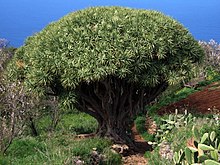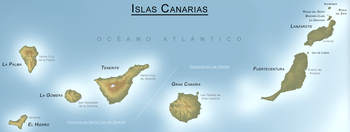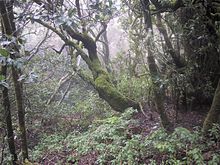Flora and vegetation of the Canary Islands
The flora of the Canary Islands is characterized by a high biodiversity and at the same time a high proportion of endemic plant species. According to current estimates, there are around 2,000 plant species in the Canary Islands. In vegetation science , the Canaries and Madeira are part of the Macaronesian region. The affiliation of the Cape Verde Islands or the Azores to this element is controversial.
history
The botanist Philip Barker Webb published the Histoire naturelle des Iles Canaries in the years 1835-1850 with Sabin Berthelot and Alfred Moquin-Tandon .
Geographical and climatic conditions
The geography of the Atlantic islands is determined by their location in subtropical latitudes and their proximity to Africa. Lanzarote is only 140 kilometers west of the Moroccan coast.
The islands are entirely of volcanic origin, were never connected to the mainland and owe their formation in the Tertiary to a weak zone in the earth's crust. The Pico del Teide on Tenerife is the highest mountain in the archipelago at 3,718 meters. The easternmost island of Lanzarote was formed an estimated 19 million years ago and is the oldest and flattest island in the group. El Hierro has existed for less than a million years.
The climate is very diverse. On the one hand, the northeast trade winds and the ocean currents have a balancing effect. On the other hand, there is a climate rhythm with summer dry periods and winter rainfall, which, however, is varied in many ways on the north and south sides of the islands.
On the eastern islands, but also in the lower level - especially on the south side - of the remaining islands, the annual rainfall is often well below 200 mm. On the other five islands that prop up the northeast side Passat clouds in between 600m and 1,500 meters and provide rainfall up to 1,000 mm. In addition, there is the moisture from fog condensation . Above this level the amount of precipitation decreases again. In the highest mountain level, only 300 mm are measured.
The temperatures of the lower elevations, especially the north side, are very balanced and fluctuate between 15 ° C and 20 ° C with an average of 18 ° C. In the highest mountain regions, the average values drop to around 9 to 10 ° C and frosts and snowfall are also to be expected.
biodiversity

Due to the diverse habitats and strong altitude zoning as well as the remoteness, a high level of biodiversity has developed.
The absence of various climatic changes, such as ice ages, ensured the survival of many relic species. These endemics are also known as paleo-endemics.
Due to the very different environmental conditions in a small area, such as amount of precipitation, altitude, humidity or substrate, new species could be formed through evolutionary processes ( adaptive radiation ). This was also made possible by geographical isolation. This group of plants is attributed to the neo-demites.
Endemism
The number of endemic creatures is very different for different groups. Less than 9 percent of the algae are endemic taxa. For mushrooms it is around 10%. The situation is similar with mosses with 5.6 percent. Vascular plants (Tracheobionta) make up the largest proportion with 575 Macaronesian endemics, 514 of which are Canarian endemics. The proportion of Canarian endemics is 25.9 percent, of which 57 percent occur exclusively on an island. Tenerife occupies a special position here, as only here are all vegetation zones fully developed due to their height and area.
Also worth mentioning are the genera Echium and Aeonium , which have their center of diversity in the Canary Islands with 24 and 35 endemic species, respectively.
Floral relationships

The constituent of autochthonous vascular plants was fed from two sources:
Mesogenic contingent
The mesogenic contingent includes the flora that developed on the edges of the former Tethys Sea, in the area of today's Mediterranean. The plants exhibited tropical and subtropical characteristics that were also common in Europe, but were drastically restricted by the penetration of the glaciers in the Quaternary. Descendants of these species can be found in the laurel forests of the islands, such as Laurus azorica and Ilex canariensis .
African contingent
Today's species from this contingent go back to xerophilic species of the marginal flora that once extended from South Africa to the north of the continent. Due to their properties, they are mainly found in low, dry zones. These include representatives of the genera Dracaena , Euphorbia , Aeonium and Ceropegia .
vegetation
For the archipelago, four altitudes with precipitation-dependent variants are usually distinguished: infra-canary, thermo-canary, meso-canary, and supra-canary. A fifth, highest level is only given for Tenerife: Orocanarian.
The following vegetation levels, some of which have very different height limits due to exposure, are based on the information provided by Rivas-Martínez .
Coastal vegetation
Coastal vegetation occupies a special position, as it is not determined by climatic factors but by the nature of the soil or the chemical composition. This is also known as azonal vegetation .
Halophilic belt
The spray zone of the cliffs is dominated by halophytic dwarf shrubs with little ground cover. An unstable, porous subsoil is characteristic, which means that the plants are limited to crevices in the basalt soils and areas with a slight slope that hold back some earth. Typical species are: Astydamia latifolia , Frankenia ericifolia , Lycium intricatum , Schizogyne sericea , Limonium pectinatum and Argyranthemum frutescens .
Psammophilic vegetation
Sand plants grow mainly on Lanzarote, Fuerteventura and Gran Canaria, where there are also sand areas and shifting dunes. The most representative species of this vegetation include: Traganum moquinii , Chenoleoides tomentosa , Polycarpaea nivea , Polygonum maritimum or beach spurge ( Euphorbia paralias ).
Infra-Canarian stage succulent bush
At altitudes up to 800 meters (in the north facing no higher than 400, in the south facing up to 800 meters) there is great drought on all islands with annual rainfall below 300 mm. Extreme heat and intense sunlight also create extreme living conditions. In this arid-semi-arid climate, plants dominate that exhibit adaptation strategies such as succulence , leaf shedding, reduction of the leaf surface or hair formation.
Succulent, cactus-like milkweed plants such as Euphorbia canariensis or the deciduous shrub Euphorbia balsamifera, which sheds deciduous trees in the summer dry season , are particularly important . Other families such as the silk plant family (Asclepiadoideae) are succulent representatives such as species of the genus Ceropegia . The succulent sunflower plant Senecio kleinia is also very widespread . Other typical species are: Echium decaisnei , Plocama pendula , Periploca laevigata and Rubia fruticosa .
The destroyed succulent bush is followed by species such as Euphorbia regis-jubae , Launaea arborescens and Neochamaelea pulverulenta .
Thermosclerophyll vegetation
This zone is not dominated by a homogeneous plant community, but is very different depending on the orientation of the location and island. However, moderate temperatures between 16 and 18 ° C and moderate water shortage are decisive. The average annual precipitation is less than 500 mm, in summer there is a lack of water. Many warmth-loving hardwood plants thrive here in a strip of 50 to 500 meters. Since this area is very suitable for agriculture, the natural vegetation has been strongly pushed back. The following formations are worth mentioning:
- Natural stands of the olive tree ( Olea europaea subsp. Cerasiformis ) in the western part of Gran Canaria.
- Pistacia atlantica in the western part of Gran Canaria
- Pistacia lentiscus in the northeast of Gran Canaria between 300 and 500 meters.
- Palm groves from Phoenix canariensis grow from coastal locations that are not directly influenced by the sea to heights of 600 m. There are still beautiful stocks on Gran Canaria and La Gomera.
- Juniper vegetation, dominated by Juniperus phoenicea subsp. canariensis on Gomera and Hierro.
Laurel forests of the thermo-Canarian level
This evergreen forest originated in the Tertiary and was also widespread in Europe before it was wiped out by the Ice Ages. Under the influence of the trade wind between 200 and 1,400 meters high, with an annual temperature of a maximum of 15 ° C and precipitation amounts of around 1,000 mm per year, optimal development conditions for this relic vegetation prevail. The four laurel plants (Lauraceae) that form the laurel forest are characteristic of the laurel forest : Azores laurel ( Laurus azorica ), Persea indica , Apollonias barbujana and Ocotea foetens . Laurel forests are missing on Lanzarote and Fuerteventura and can be found on the remaining islands in varying degrees of conservation. Beautiful stocks can still be found in the Anaga Mountains on Tenerife, Garajonay National Park on La Gomera and in the Los Tilos nature reserve on La Palma.
With increasing drought, but also after clearing of the laurel forests, they turn into tree heather bush forests (Fayal-Brezal), which are dominated by Erica arborea and Myrica faya .
Canary Islands pine forests of the Mesocanarian level
The pine forests between 1,200–2,000 meters high are very species-poor formations, which are mainly dominated by the Canarian pine ( Pinus canariensis ). Depending on the orientation of the location, these forests occur in sheltered places above the thermophilic vegetation, on the windward side above the laurel forests. The cistus Cistus monspeliensis and Cistus symphytifolius can be found in dry locations in the undergrowth . Erica arborea and Chamaecytisus proliferus predominantly thrive in wetter locations .
Supra-Canarian stage

At heights above 2,000 meters, which can only be reached in Tenerife and La Palma, where trees can no longer grow due to the climatic conditions, low shrubs predominate. On Tenerife this is mainly the Teide gorse ( Cytisus supranubius ), while on La Palma it is mainly Adenocarpus viscosus that predominates. Many endemic plants also grow together with these species, with the endemic proportion at this altitude being 80 percent. Worth mentioning are: Genista benehoavensis , Descurainia bourgeauana , Echium wildpretii , Pterocephalus porphyranthus , Micromeria lasiophylla , Erysimum scoparium . The vegetation at this altitude is of great importance as protection against erosion and used to be used as fodder crops in the spring and summer months, especially for goats.
At altitudes above 2,800 meters, which can only be reached on Tenerife, very few plants such as the Teide violet ( Viola cheiranthifolia ) thrive .
Special locations
The special orography of the Canaries with deeply cut gorges (Barrancos), cliffs (Riscos) and steep slopes offers a special location for many endemic plants. The rocky gorges sometimes run through all levels of altitude on the respective island. The flora that lives there is correspondingly different. Examples are: Riscos de Famara on Lanzarote, the rocky landscape of Jandia on Fuerteventura, Tenteniguada or Tirajana on Gran Canaria, Anaga Mountains on Tenerife, El Golfo on Hierro Island, Caldera de Taburiente on La Palma and Garajonay on Gomera.
Species of the halophilic belt predominate in the rocky corridors of the cliffs and cliffs. The higher-level flora is more diversified and contains many endemic species, particularly of the genera Aeonium , Aichryson , Sonchus, and Carlina .
literature
- Brigittaerschbamer (head): excursion abroad Tenerife - 29.04. until 6.5. 2016 , Institute of Botany, University of Innsbruck , online excursion report
- Ingrid Schönfelder, Peter Schönfelder : Kosmos Atlas Mediterranean and Canary Islands flora. Over 1600 species of plants . 2nd Edition. Franckh-Kosmos, Stuttgart 2002, ISBN 3-440-09361-1 .
Web links
- Flora Vascular de Canarias, a Spanish page with numerous illustrations
- Flora canaria (Kosmos-Verlag), with extensive picture list
Individual evidence
- ↑ a b Miguel Ángel Cabrera Pérez: The native flora of the Canary Islands , 1999, ISBN 84-241-3550-4
- ^ Günther Kunkel: The Canary Islands and their flora , Gustav Fischer Verlag, Stuttgart, Jena, New York 1993, ISBN 3-437-20491-2 .
- ^ Adalbert Hohenester, Walter Welss: Excursion flora for the Canary Islands. With views of the whole of Macaronesia . Eugen Ulmer, Stuttgart (Hohenheim) 1993, ISBN 3-8001-3466-7 ( PDF file; 23.2 MB ).
- ↑ Werner Nezadal , Roland Lindacher, Walter Welss: Local endings and phytodiversity of the western Canadian islands of La Palma and La Gomera . In: Feddes Repertorium 110 (1-2), 1999: 19-30. doi : 10.1002 / fedr.19991100107



